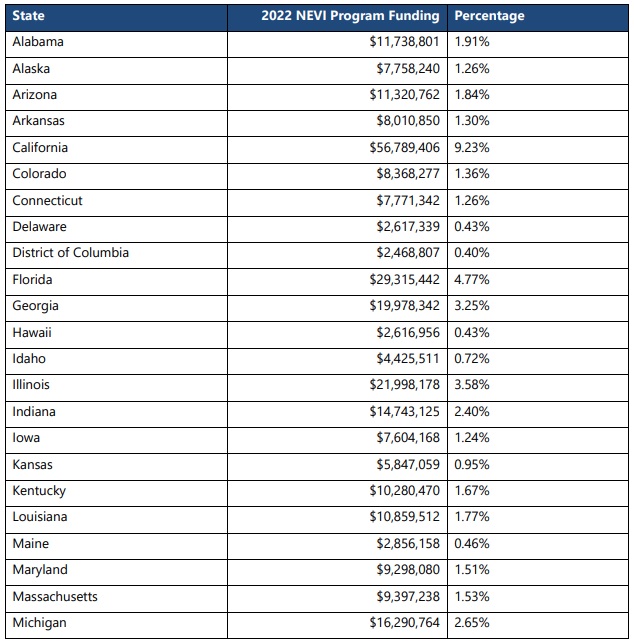Allocations of $615 million in funds for electric vehicle (EV) infrastructure in the US under the National Electric Vehicle Infrastructure Formula Program (NEVI Program) moved forward with recent publications from the US Department of Transportation (DOT). The funds will be allocated on a state-by-state basis—with some receiving far more than others—but the first step will be for each state to propose a plan for its allocated share of funds (Plan). The DOT's February 10, 2022 memorandum provided new details about the NEVI Program, which was created pursuant to the Infrastructure Investment and Jobs Act. Specifically, the guidance confirmed amounts to be allocated to each state (plus the District of Columbia and Puerto Rico).1
States must submit an EV Infrastructure Deployment Plan to the Joint Office of Energy and Transportation by August 1, 2022, to be eligible for funding. The Federal Highway Administration (FHWA) and the Joint Office will review each Plan and approve eligible Plans by September 30, 2022. If a state fails to submit a Plan or if a state's Plan is not accepted, FHWA may withhold or withdraw funds allocated to that state. Funds would then be awarded on a competitive basis to local jurisdictions for use on projects within the state. If funds cannot be awarded to local jurisdictions, the funds will be distributed among other states.
Each Plan is expected to include:
- An introduction to the Plan and a description of its development process.
- How the state's department of transportation has coordinated with that state's energy or environmental department in the development of the Plan and a discussion of the efforts made by the state department of transportation to maximize opportunities to utilize EV supply equipment that is manufactured in the United States.
- A discussion of the involvement of stakeholder groups such as the general public, labor organizations and underserved or disadvantaged communities in the Plan's development.
- How the Plan supports an efficient, affordable and equitable statewide and national EV network, how the state intends to use the funds made available to it and 5-year goals.
- A discussion on contracting with the private sector to efficiently deploy and deliver the Plan.
- Identification of the existing and future climate, market and civil conditions within the Plan's study area, including existing EV charging infrastructure.
- A discussion of the EV charging infrastructure installations and associated policies to meet the goals of the Plan
- Identification of non-Federal sources of funding and coordination with other states and their EV charging networks.
- How the Plan will comply with civil rights laws and how the Plan will be developed in consideration of rural, underserved and disadvantaged communities.
- Detail on what steps will be taken to grow, train and diversify the local workforce who will be installing, operating and maintain the EV charging infrastructure.
- How the state will consider and address cybersecurity issues.
- A discussion on how the state plans to evaluate its performance under its Plan.
The NEVI Program guidance also specifies other factors the USDOT Secretary and the Energy Secretary must consider in developing guidance for states and localities to strategically deploy EV charging infrastructure, which include:
- The distance between EV charging infrastructure (new installations should be less than 50 miles apart and within a mile from Interstate exits or highway intersections).
- Reliability of power, mitigation of adverse impacts to the grid, pricing, alignment with electric distribution interconnection processes and opportunities to leverage energy storage and renewable energy sources.
- The proximity of existing off-highway travel centers.
- The need for charging infrastructure in rural corridors and underserved or disadvantaged communities. The guidance suggests a target of 40 percent of the benefits going towards these communities.
- Long-term operation and maintenance of publicly available EV charging infrastructure to avoid stranded assets.
- Existing EV infrastructure programs and incentives.
- Fostering enhanced, coordinated, public-private or private investment in EV charging infrastructure to spur additional private investment in EV infrastructure.
- Meeting current and anticipated market demands for EV charging infrastructure, including with regard to power levels and charging speed, and minimizing the time to charge current and anticipated vehicles. All EV charger stations installed as part of the NEVI Program should be Direct-Current Fast Chargers, with at least four ports and should deliver at least 150kW per port. State Plans should consider the potential for future expansions and future upgrades.
FHWA is expected to propose regulations for minimum standards and requirements for the NEVI Program by May 13. These will be more detailed requirements for states to follow when implementing their Plans. These new regulations are expected to include details on installation, operations and maintenance of EV infrastructure; data collection and sharing; network connectivity and payments; and accessibility of information on station availability, pricing and locations.
Distribution of Funds
The current $615 million allocation is just for 2022; appropriations will be made in each of FY 2022- 2026. Apportionment among the states, the District of Columbia and Puerto Rico of the NEVI Program funds (shown below for fiscal year 2022) is proportional based on each state's share of amounts that FHWA distributes in federal-aid highway apportionments and Puerto Rico Highway Program funding.
As each state prepares its plans, Mayer Brown expects that opportunities for involvement by the private sector will emerge. Outside of procurement and construction of charging infrastructure, opportunities are possible in real estate, energy (particularly distributed generation) and public-private partnerships, particularly due to the possibility of multi-year funding for this program. By requiring each state to develop its own Plan, the DOT effectively is encouraging several solutions to develop, with the most efficient and effective ones being adopted by more states until the market settles on a standard approach (or approaches) to using these funds.


Footnote
1 For our previous coverage of the potential impact of the IIJA on EVs and related charging infrastructure, please also see our prior Legal Updates: " US Infrastructure Investment and Jobs Act of 2021 – Assessing the Potential Impact on Electric Vehicles and Electric Vehicle Infrastructure" and " Progress for America's Infrastructure under the Infrastructure Investment and Jobs Act."
Visit us at mayerbrown.com
Mayer Brown is a global legal services provider comprising legal practices that are separate entities (the "Mayer Brown Practices"). The Mayer Brown Practices are: Mayer Brown LLP and Mayer Brown Europe – Brussels LLP, both limited liability partnerships established in Illinois USA; Mayer Brown International LLP, a limited liability partnership incorporated in England and Wales (authorized and regulated by the Solicitors Regulation Authority and registered in England and Wales number OC 303359); Mayer Brown, a SELAS established in France; Mayer Brown JSM, a Hong Kong partnership and its associated entities in Asia; and Tauil & Chequer Advogados, a Brazilian law partnership with which Mayer Brown is associated. "Mayer Brown" and the Mayer Brown logo are the trademarks of the Mayer Brown Practices in their respective jurisdictions.
© Copyright 2020. The Mayer Brown Practices. All rights reserved.
This Mayer Brown article provides information and comments on legal issues and developments of interest. The foregoing is not a comprehensive treatment of the subject matter covered and is not intended to provide legal advice. Readers should seek specific legal advice before taking any action with respect to the matters discussed herein.





